Unit 7 Will people have robots全单元表格教案 共6课时
文档属性
| 名称 | Unit 7 Will people have robots全单元表格教案 共6课时 | 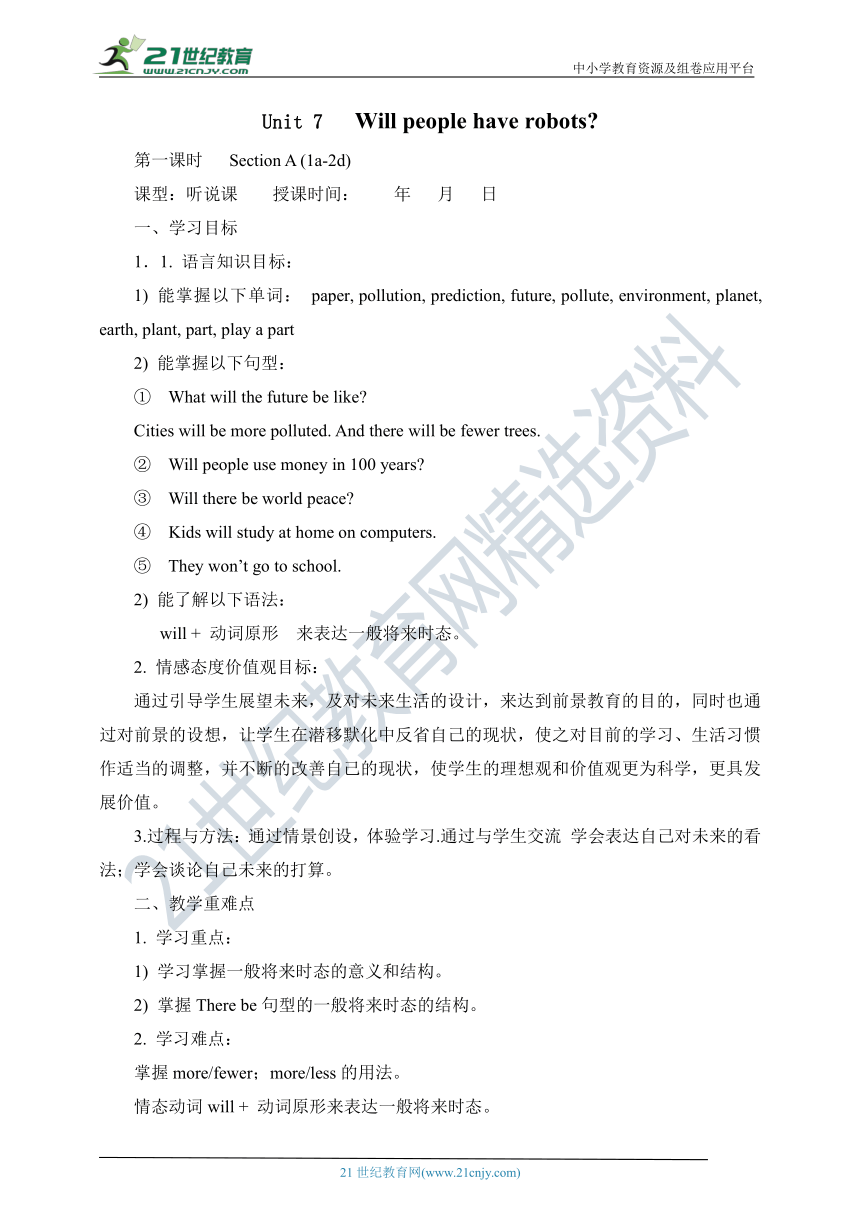 | |
| 格式 | zip | ||
| 文件大小 | 1.2MB | ||
| 资源类型 | 试卷 | ||
| 版本资源 | 人教新目标(Go for it)版 | ||
| 科目 | 英语 | ||
| 更新时间 | 2020-07-29 10:21:40 | ||
图片预览

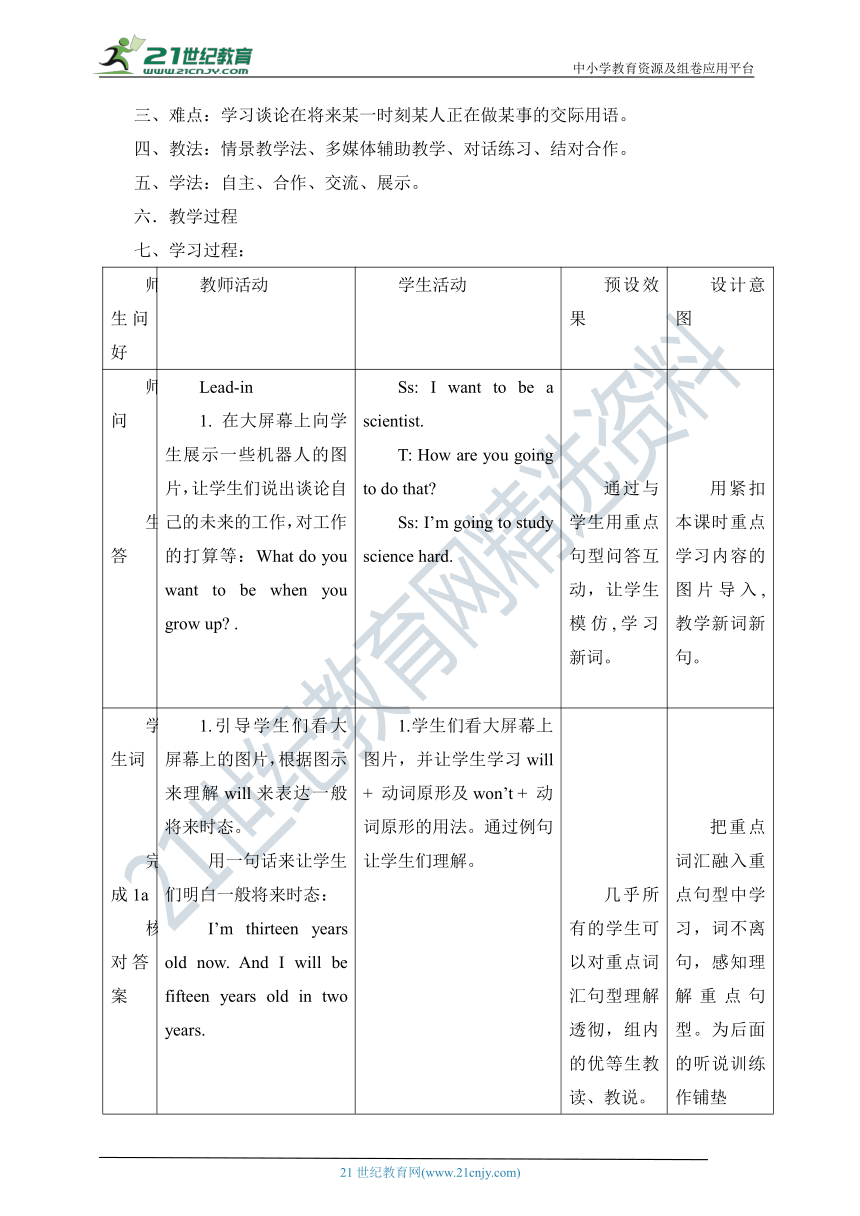
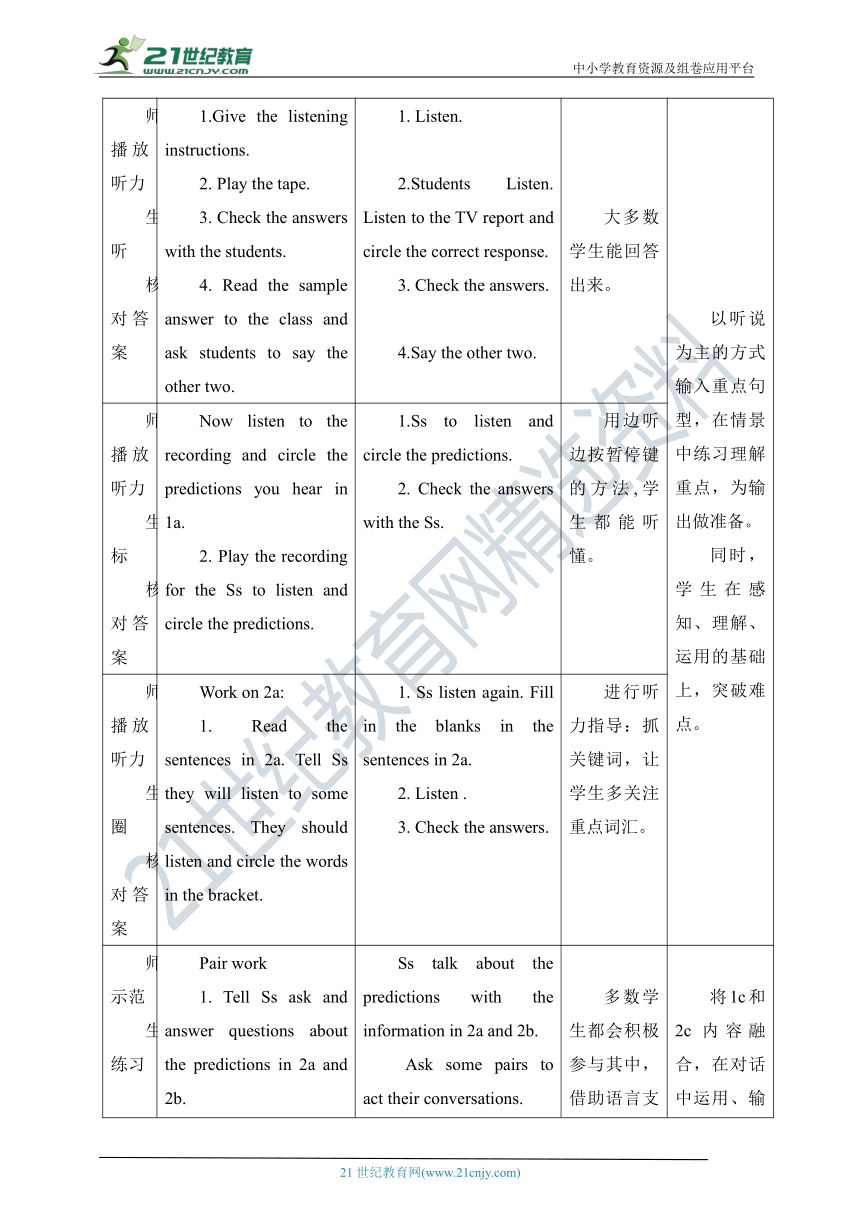
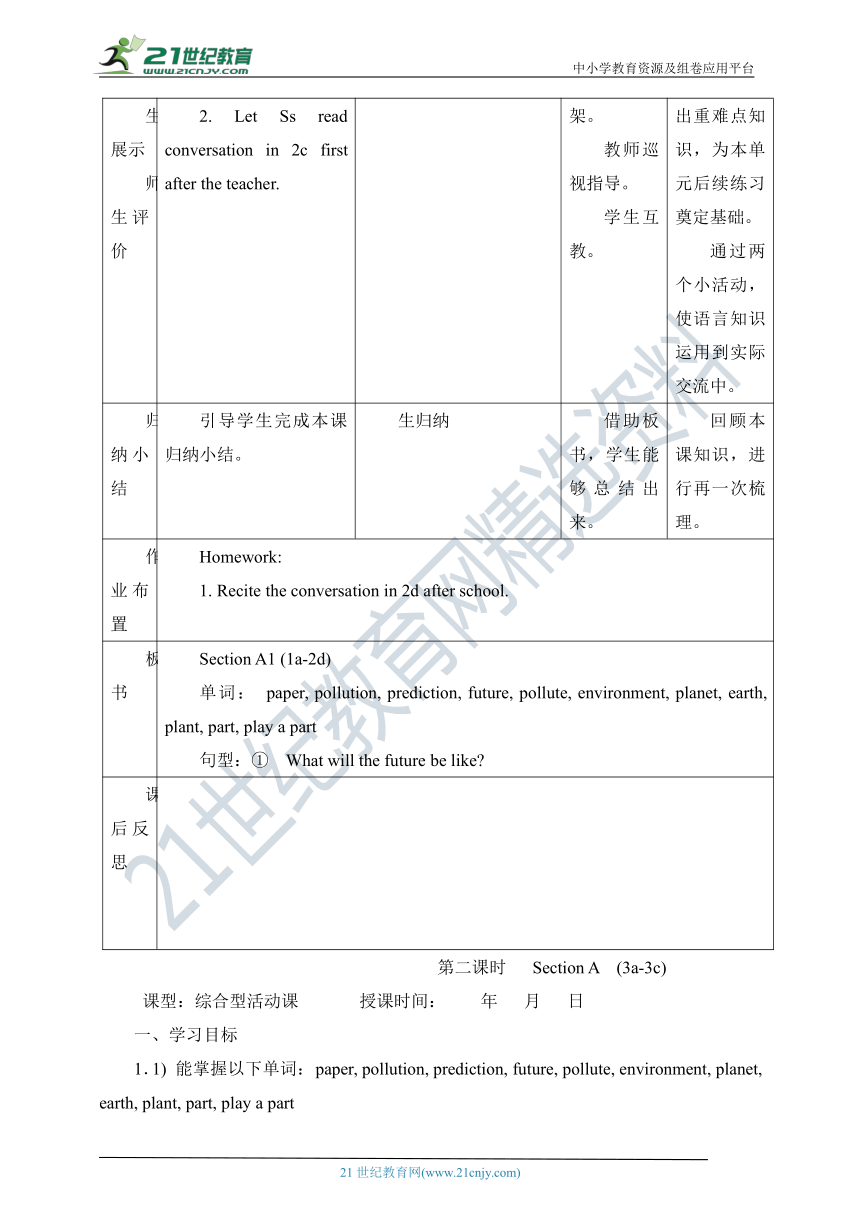
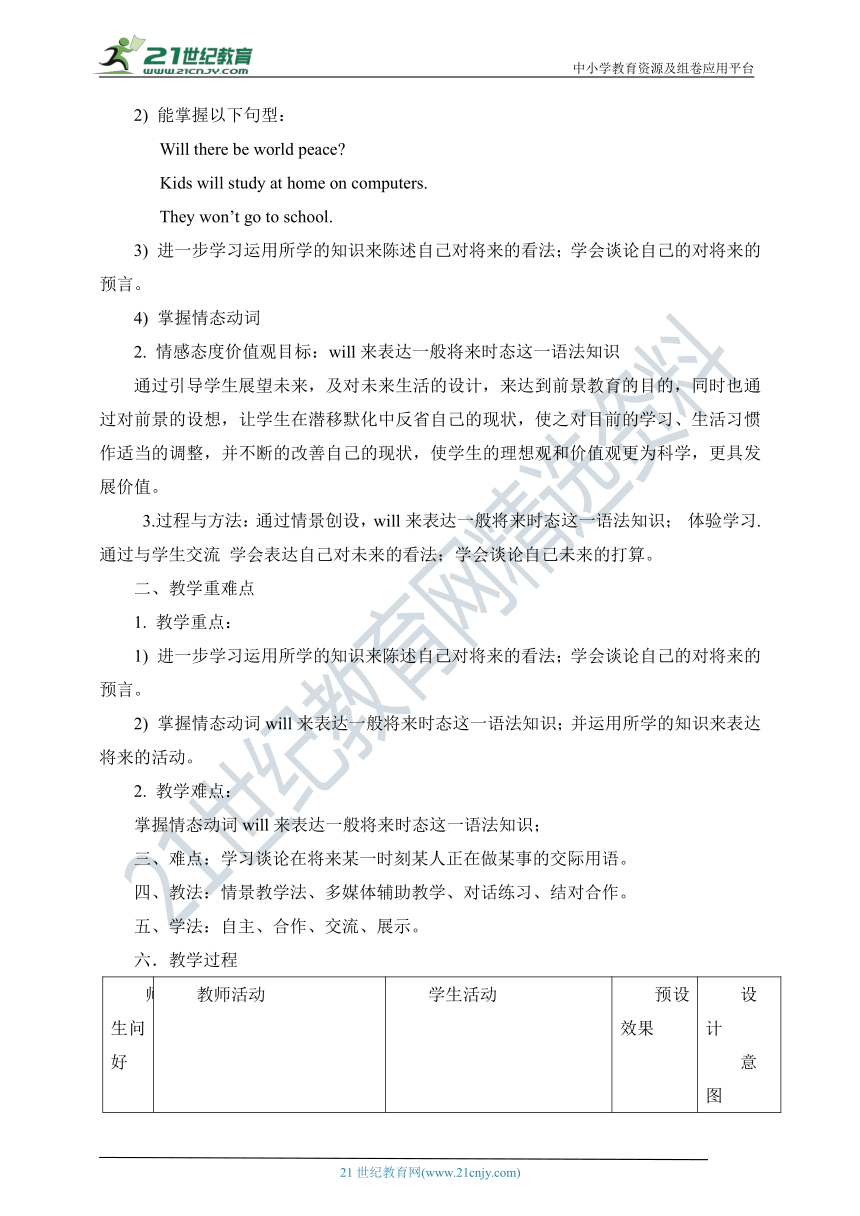
文档简介
中小学教育资源及组卷应用平台
Unit
7
Will
people
have
robots?
第一课时
Section
A
(1a-2d)
课型:听说课
授课时间:
年
月
日
一、学习目标
1.1.
语言知识目标:
1)
能掌握以下单词:
paper,
pollution,
prediction,
future,
pollute,
environment,
planet,
earth,
plant,
part,
play
a
part
2)
能掌握以下句型:
①
What
will
the
future
be
like?
Cities
will
be
more
polluted.
And
there
will
be
fewer
trees.
②
Will
people
use
money
in
100
years?
③
Will
there
be
world
peace?
④
Kids
will
study
at
home
on
computers.
⑤
They
won’t
go
to
school.
2)
能了解以下语法:
will
+
动词原形
来表达一般将来时态。
2.
情感态度价值观目标:
通过引导学生展望未来,及对未来生活的设计,来达到前景教育的目的,同时也通过对前景的设想,让学生在潜移默化中反省自己的现状,使之对目前的学习、生活习惯作适当的调整,并不断的改善自己的现状,使学生的理想观和价值观更为科学,更具发展价值。
3.过程与方法:通过情景创设,体验学习.通过与学生交流
学会表达自己对未来的看法;学会谈论自己未来的打算。
二、教学重难点
1.
学习重点:
1)
学习掌握一般将来时态的意义和结构。
2)
掌握There
be句型的一般将来时态的结构。
2.
学习难点:
掌握more/fewer;more/less的用法。
情态动词will
+
动词原形来表达一般将来时态。
三、难点:学习谈论在将来某一时刻某人正在做某事的交际用语。
四、教法:情景教学法、多媒体辅助教学、对话练习、结对合作。
五、学法:自主、合作、交流、展示。
六.教学过程
七、学习过程:
师生问好
教师活动
学生活动
预设效果
设计意图
师问生答
Lead-in
1.
在大屏幕上向学生展示一些机器人的图片,让学生们说出谈论自己的未来的工作,对工作的打算等:What
do
you
want
to
be
when
you
grow
up?
.
Ss:
I
want
to
be
a
scientist.
T:
How
are
you
going
to
do
that?
Ss:
I’m
going
to
study
science
hard.
通过与学生用重点句型问答互动,让学生模仿,学习新词。
用紧扣本课时重点学习内容的图片导入,教学新词新句。
学生词完成1a核对答案
1.引导学生们看大屏幕上的图片,根据图示来理解will来表达一般将来时态。
用一句话来让学生们明白一般将来时态:
I’m
thirteen
years
old
now.
And
I
will
be
fifteen
years
old
in
two
years.
1.学生们看大屏幕上图片,并让学生学习will
+
动词原形及won’t
+
动词原形的用法。通过例句让学生们理解。
几乎所有的学生可以对重点词汇句型理解透彻,组内的优等生教读、教说。
把重点词汇融入重点句型中学习,词不离句,感知理解重点句型。为后面的听说训练作铺垫
师播放听力生听核对答案
1.Give
the
listening
instructions.2.
Play
the
tape.3.
Check
the
answers
with
the
students.4.
Read
the
sample
answer
to
the
class
and
ask
students
to
say
the
other
two.
1.
Listen.2.Students
Listen.
Listen
to
the
TV
report
and
circle
the
correct
response.3.
Check
the
answers.
4.Say
the
other
two.
大多数学生能回答出来。
以听说为主的方式输入重点句型,在情景中练习理解重点,为输出做准备。同时,学生在感知、理解、运用的基础上,突破难点。
师播放听力生标核对答案
Now
listen
to
the
recording
and
circle
the
predictions
you
hear
in
1a.
2.
Play
the
recording
for
the
Ss
to
listen
and
circle
the
predictions.
1.Ss
to
listen
and
circle
the
predictions.
2.
Check
the
answers
with
the
Ss.
用边听边按暂停键的方法,学生都能听懂。
师播放听力生圈核对答案
Work
on
2a:
1.
Read
the
sentences
in
2a.
Tell
Ss
they
will
listen
to
some
sentences.
They
should
listen
and
circle
the
words
in
the
bracket.
1.
Ss
listen
again.
Fill
in
the
blanks
in
the
sentences
in
2a.
2.
Listen
.3.
Check
the
answers.
进行听力指导:抓关键词,让学生多关注重点词汇。
师示范生练习生展示师生评价
Pair
work
1.
Tell
Ss
ask
and
answer
questions
about
the
predictions
in
2a
and
2b.
2.
Let
Ss
read
conversation
in
2c
first
after
the
teacher.
Ss
talk
about
the
predictions
with
the
information
in
2a
and
2b.
Ask
some
pairs
to
act
their
conversations.
多数学生都会积极参与其中,借助语言支架。教师巡视指导。学生互教。
将1c和2c内容融合,在对话中运用、输出重难点知识,为本单元后续练习奠定基础。通过两个小活动,使语言知识运用到实际交流中。
归纳小结
引导学生完成本课归纳小结。
生归纳
借助板书,学生能够总结出来。
回顾本课知识,进行再一次梳理。
作业布置
Homework:
1.
Recite
the
conversation
in
2d
after
school.
板书
Section
A1
(1a-2d)单词:
paper,
pollution,
prediction,
future,
pollute,
environment,
planet,
earth,
plant,
part,
play
a
part
句型:①
What
will
the
future
be
like?
课后反思
第二课时
Section
A
(3a-3c)
课型:综合型活动课
授课时间:
年
月
日
一、学习目标
1.1)
能掌握以下单词:
paper,
pollution,
prediction,
future,
pollute,
environment,
planet,
earth,
plant,
part,
play
a
part
2)
能掌握以下句型:
Will
there
be
world
peace?
Kids
will
study
at
home
on
computers.
They
won’t
go
to
school.
3)
进一步学习运用所学的知识来陈述自己对将来的看法;学会谈论自己的对将来的预言。
4)
掌握情态动词
2.
情感态度价值观目标:will来表达一般将来时态这一语法知识
通过引导学生展望未来,及对未来生活的设计,来达到前景教育的目的,同时也通过对前景的设想,让学生在潜移默化中反省自己的现状,使之对目前的学习、生活习惯作适当的调整,并不断的改善自己的现状,使学生的理想观和价值观更为科学,更具发展价值。
3.过程与方法:通过情景创设,will来表达一般将来时态这一语法知识;
体验学习.通过与学生交流
学会表达自己对未来的看法;学会谈论自己未来的打算。
二、教学重难点
1.
教学重点:
1)
进一步学习运用所学的知识来陈述自己对将来的看法;学会谈论自己的对将来的预言。
2)
掌握情态动词will来表达一般将来时态这一语法知识;并运用所学的知识来表达将来的活动。
2.
教学难点:
掌握情态动词will来表达一般将来时态这一语法知识;
三、难点:学习谈论在将来某一时刻某人正在做某事的交际用语。
四、教法:情景教学法、多媒体辅助教学、对话练习、结对合作。
五、学法:自主、合作、交流、展示。
六.教学过程
师生问好
教师活动
学生活动
预设效果
设计意图
师导入语生模仿回答
1.Show
some
pictures
and
let
Ss
talk
about
them
in
phrases.2
What
will
the
future
be
like?
1.倾听,感知,回答:Ss
review.be
more
crowded
and
pollutedbe
in
great
danger
通过与学生用重点句型问答互动,让学生模仿教师谈论。
用紧扣本课时重点学习内容的话题导入,自然进入新课。
学习对话句型
Tell
Ss
ask
and
answer
questions
about
the
predictionsLet
Ss
read
conversation
in
first
after
the
teacherAsk
some
pairs
to
act
their
conversations.
1.Ss
talk
about
the
predictions
with
the
information
2..
Ask
some
pairs
to
act
their
conversations.
大部分的学生可以对重点词汇句型理解透彻,部分人可能会对重点词汇读不准确。组内的优等生教读、教说。
把重点词汇融入重点句型中学习,词不离句,感知理解重点句型。为后面的听说训练作铺垫。
师出示例子生练习生展示
1Role-play
1.
Read
the
conversations
and
answer
the
questions:
1)
What
will
the
future
be
like
in
the
book?
2)
What
can
people
do?2.
Explain
some
new
words
and
main
points
in
the
conversation.
be
in
great
danger,
move
to
other
planets;
play
a
part;
1.Read
the
conversation
after
the
teacher.
2.
Practice
the
conversation
with
their
partner.
Then
let
some
pairs
to
act
out
the
conversation
教读难点词汇。借助板书指导。进行阅读指导:抓关键词,让学生多关注重点词汇。学生问题不大,个别辅导。
在阅读练习中运用、输出重难点知识.同时篇章的阅读提高学生的阅读能力。
师指导生练习核对答案
1.Good
job.
Let’s
complete3c.2.
Check
the
answers.
1.
Discuss
the
questions
with
a
partner..
2.Check
the
answers
and
read
together.
给出语言支架
检测重点单词句型的使用情况。
归纳小结
引导学生完成本课归纳小结。
生归纳
借助板书,学生能够总结出来。
回顾本课知识,进行再一次梳理。
作业
用下列词组来造句:
(1)
be
more
crowded
and
polluted
(2)
be
fewer
trees(3)
be
in
great
danger
(4)
on
the
earth
(5)
less
water
(6)
playa
part
板书
will
people
use
money
in
100
years?
Will
there
be
world
peace?
Kids
will
study
at
home
on
computers.
They
won’t
go
to
school.
反思
第三课时Section
A(Grammar
focus-4c)
课型:语法课
授课时间:
年
月
日
一、学习目标
1.
语言知识目标:
1)
学习掌握下列词汇:peace,
sea,
sky
2)
进行一步复习巩固运用Section
A
部分所学的生词和词组。
3)
进一步学习运用所学的知识来陈述自己对将来的看法;学会谈论自己的对将来的预言。
4)
掌握情态动词will来表达一般将来时态这一语法知识;
2.
情感态度价值观目标:
通过引导学生展望未来,及对未来生活的设计,来达到前景教育的目的,同时也通过对前景的设想,让学生在潜移默化中反省自己的现状,使之对目前的学习、生活习惯作适当的调整,并不断的改善自己的现状,使学生的理想观和价值观更为科学,更具发展价值。
3.过程与方法:通过情景创设,will来表达一般将来时态这一语法知识;
体验学习.通过与学生交流
学会表达自己对未来的看法;学会谈论自己未来的打算。
二、教学重难点
1.
教学重点:
1)
进一步学习运用所学的知识来陈述自己对将来的看法;学会谈论自己的对将来的预言。
2)
掌握情态动词will来表达一般将来时态这一语法知识;并运用所学的知识来表达将来的活动。
2.
教学难点:
掌握情态动词will来表达一般将来时态这一语法知识;
四、教法:情景教学法、多媒体辅助教学、对话练习、结对合作。
五、学法:自主、合作、交流、展示。
六、学习过程
七、学习过程:
学习环节
教师活动
学生活动
预设效果
设计意图
师导生听生模仿
1Ask
some
Ss
to
give
some
predictions.
T:
What’s
your
prediction
about
the
future?
S1:
There
will
be
less
free
time.
S2:There
will
be
more
pollution.
1.倾听,感知,回答:T:
What’s
your
prediction
about
the
future?
S1:
There
will
be
less
free
time.
S2:There
will
be
more
pollution.
学生大多能说出短语,不会的同桌互教。
复习旧知,导入新课。
学习生词巩固运用重点句型
Grammar
Focus.
1.
学生阅读Grammar
Focus中的句子,然后做填空练习。
①
What
______the
____
be
_____?
2.
Cities
____
___
_____
polluted.
And
there
____
_____
_______.③____
people
____
money
___
100
years?
No,
they
______.
Everything
____________.
学生们根据记忆,看大屏幕来完成填空练习。
3.
学生们完成填空试题后,可以打开课本检查答案,对错误的句子,单独进行强化记忆。
Yes,
I
______
_____.
Kids
_____
______
at
home
_____
_______.
They
______
_______
to
school.
几乎所有的学生可以读会重点词汇,组内的优等生教读、教说。绝大多数学生能做出,但也会出现一些语法错误,优等生纠正,教师补充。绝大多数学生能这项练习,但也会出现一些语法错误,教师给出语言支架。
通过学生练习,自主获得本课的语法知识点,培养学生的自主学习能力
师指导生练习展示
1.Practice
Work
on
3a:
1.
Tell
Ss
to
read
the
conversation
in
3a
and
try
to
fill
in
the
blanks
with
more/
less
or
fewer.
2.
方法指导:应通读整个对话,掌握对话大意;There
be
句型的一般将来时结构:肯定式:There
+
________
+
其他否定式:
There
+
___________
+
其他一般疑问句:____________
+
be
+
其他?
1.学生们阅读这些句子并试着记住这些句子.有些名词前有形容词来修饰。
2.
最后,教师与同学们一起校对答案,并对学生们有疑问的地方进行解释。be
动词形式的确定要根据其后面的名词
单复数形式来确定。
_____
_____
an
apple
tree
in
the
park.
_____
______
many
people
in
the
park
today.
部分学生不能正确写出答案,师可给出方法指导:首先,先阅读所给的词组,明确每个词组的意思。
其次,通读全句,理解大意;然后,根据句意及句子中上下文意的提示来确定空格处的意思。
以练习为主的方式巩固重点句型,在情景中练习理解重点,突破难点。
师出示语言支架生练习生展示师生评价
1.
Read
the
instructions
and
the
conversation
to
the
class,
and
then
ask
students
to
make
similar
conversations.2.
Ask
some
pairs
to
present
their
conversations.
3.Act
out.
1.
Listen.2.
One
student
mimes
a
problem.
The
other
students
inyour
group
guess
the
problem
and
give
advice.
3.Act
out
in
pairs.
多数学生都会积极参与其中,借助语言支架。教师巡视指导。学生互教。
在对话中运用、输出重难点知识,为本单元后续练习奠定基础。
作业布置
习Grammar
Focus
中的内容。展开你想象的翅膀,想一下50年后,你的生活将会怎么样?并写六个句子来描
板书
1.
I
will
almost
see
the
blue
skies
every
day.
2.
people
will
live
to
be
200
years
old.
3.
families
will
spend
time
together
every
day.
课后反思
第四课时
Section
B
1a-1d
课型:听说课
授课时间:
年
月
日
一、学习目标
1.1.
语言知识目标:
1)
能掌握以下单词:apartment,
rocket,
space,
space
station,
even,
human,
servant,
dangerous,
already,
factory,
simple,
over
and
over
again,
believe,
hundreds
of,
inside,
disagree,
shape,
fall,
fall
down,
look
for,
possible,
impossible
2)
能掌握以下句型:
①
—Where
do
you
live?
—I
live
in
an
apartment.
②
There
are
already
robots
working
in
factories.
③
It’s
easy
for
children
to
wake
up
and
know
where
they
are.
3)
能综合运用will表达一般将来时态。
2.
情感态度价值观目标:
通过引导学生展望未来,及对未来生活的设计,来达到前景教育的目的,同时也通过对前景的设想,并不断的改善自己的现状,使学生的理想观和价值观更为科学,更具发展价值。
3.
过程与方法:通过情景创设,will来表达一般将来时态这一语法知识;
体验学习.通过与学生交流
学会表达自己对未来的看法;学会谈论自己未来的打算。
二、教学重难点
1.
教学重点:
1)
掌握本课时出现的生词及表达方式。
2)
进行听力训练,提高综合听说能力。
3)
阅读短文,获得相关信息,提高学生们的综合阅读能力。
2.
教学难点
1.
听力训练
2.
阅读1b部分的短文并完成相关要求。
四、教法:情景教学法、多媒体辅助教学、结对合作。
五、学法:自主、合作、交流、展示。
六、学习过程
七、学习过程:
学习环节
教师活动
学生活动
预设效果
设计意图
师导入生听理解模仿说
1.Warming-
up
and
revision1.
Daily
greeting.
2.
复习情态动词will
构成的一般将来时态的构成。
3.
复习more,
fewer,
less
后面所跟名词的情况。
学生们谈谈自己所画的未来城市的前景情况。1.情态动词will
构成的一般将来时态的构成。
2.more,
fewer,
less
后面所跟名词的情况。
通过学生用重点句型问答互动,学生能对学过的知识进行运用。
复习过去时态和过去进行时态用紧扣本课时重点的话题导入,自然进入新课。
师指导生练习展示师播放听力生听核对答案
1.Lead
in
1.
Ask
Ss
some
questions:
T:
What
will
do
in
the
future?
T:
Where
will
you
live?
T:
How
will
you
go
to
work?
Get
some
Ss
think
and
answer
the
questions.
1.
Present
some
new
words
on
the
big
screen.
e.g.
apartment,
rocket,
space,
space
station,
human,
servant,
factory…2.Explain
some
main
words
to
the
Ss
.
Give
some
examples
on
the
big
screen.
部分学生对重点词汇发音不准。教读难点词汇。用边听边按暂停键的方法,只要是小学学过英语的学生都能听懂。
以听说为主的方式输入重点句型,学生在感知、理解、运用的基础上,突破难点。
师示范生练习展示师生评价
1Listening
Work
on
1c:
1.
Tell
Ss
to
listen
to
Alexis
and
Joe’s
conversation.
and
Number
the
pictures
1-3.
2.
Play
the
recording
for
the
Ss.
Ss
just
listen
for
the
first
time.
Play
the
recording
again
and
number
the
pictures.
3.
Play
the
recording
and
check
the
answers
with
the
Ss.
1.
Listen.2.Ss
just
listen
for
the
first
time.
Play
the
recording
again
and
number
the
pictures.
3.
Play
the
recording
and
check
the
answers
with
the
Ss.
听时应重点听句子的谓语动词,并明确其时态。
多数学生都会积极参与其中。教师巡视指导。学生互教。
在对话中运用、输出重难点知识,为本单元后续写作训练奠定基础。
作业布置
总结课文出现的重难点词组及表达方式。
板书
单词:apartment,
rocket,
space,
space
station,
even,
human,
servant,
dangerous,
already,
factory,
over
and
over
again,
believe,
hundreds
of,
课后反思
第五课时
Section
B
2a-3a
课型:综合型阅读课
授课时间:
年
月
日
一、教学目标:
1.
语言知识目标:
1)
能掌握以下单词:apartment,
rocket,
space,
space
station,
even,
human,
servant,
dangerous,
already,
factory,
simple,
over
and
over
again,
believe,
hundreds
of,
inside,
disagree,
shape,
fall,
fall
down,
look
for,
possible,
impossible
2)
能掌握以下句型:
①
It’s
easy
for
children
to
wake
up
and
know
where
they
are.
That
may
not
seem
possible
now,
but
computers
and
rockets
seemed
impossible
100
years
ago.
3)
能综合运用will表达一般将来时态。
2.
情感态度价值观目标:
通过引导学生展望未来,及对未来生活的设计,来达到前景教育的目的,并不断的改善自己的现状,使学生的理想观和价值观更为科学,更具发展价值。
3.
过程与方法:通过情景创设,will来表达一般将来时态这一语法知识;
体验学习.通过与学生交流
学会表达自己对未来的看法;学会谈论自己未来的打算。
二、教学重难点
1.
教学重点:
1)
掌握本课时出现的生词及表达方式。
2)
进行听力训练,提高综合听说能力。
3)
阅读短文,获得相关信息,提高学生们的综合阅读能力。
2.
教学难点
1.
情态动词will
构成的一般将来时态的构成。
2.
more,
fewer,
less
后面所跟名词的情况。.
四、教法:情景教学法、多媒体辅助教学、阅读训练、结对合作。
五、学法:自主、合作、交流、展示。
六、学习过程
学习环节
教师活动
学生活动
预设效果
设计意图
师导入生听理解模仿说
1.Work
in
groups.
Tell
your
partner
what
you
know
about
robots.
What
do
they
look
like
and
what
can
they
do?
2.
Ask
some
Ss
describe
the
robots
they
know.
1
Ask
some
Ss
describe
the
robots
they
know.
more,
less,
fewer填空。
There
will
be
_______
houseThere
will
be
_____pollutionThere
will
be
______
schoolsThere
will
be
______
people
部分学生不会表达,同伴互教。
激活学生脑海中的图式,为阅读材料做准备
师要求师指导生展示评价
Reading
1.
T:
Are
you
interested
in
robots?
Do
you
want
to
have
a
robot?
2.
Let
Ss
read
the
passage
quickly
and
complete
sentences
below
about
what
robots
can
do
now.
3.
Ss
read
the
passage
quickly
and
complete
the
three
sentences.
4.
Check
the
answers
with
the
Ss.
1.Reading
1.
T:
Now
let’s
work
on
2c.
This
time
you
should
read
the
passage
a
little
more
carefully.
Then
write
three
sentences
about
what
robots
will
be
able
to
do
in
the
future.
2.
方法指导:明确我们这次阅读的任务,然后,带着这个任务再次认真阅读短文的内容,并在相关段落中认真查找未来机器人所能做的事情。
并写出正确的答案。3.
Ss
read
carefully
and
try
to
write
the
three
sentences.
4.
Check
the
answers
with
the
class.
绝大多数学生能找出新单词,但在做阅读习题时也会出现一些错误,可告诉学生策略,快速读过去,取出读物中关键性的东西。如还是不会,可采取让优等生帮助。
要求学生在书本中画出要落实重点单词、词组和句型。呈现仔细阅读的问题任务,培养他们的根据任务阅读的能力。
师示范生练习展示师生评价
Read
the
passage
again.
This
time
you
should
read
the
passage
and
fill
in
the
blanks
in
this
paragraph
with
words
in
the
article.
1.Let
some
Ss
talk
about
their
answers.
多数学生都会积极参与其中。教师巡视指导。学生互教。
在讨论中运用、输出重难点知识。
作业布置
练习册
板书
①
—Where
do
you
live?
—I
live
in
an
apartment.
②
There
are
already
robots
working
in
factories.
③
It’s
easy
for
children
to
wake
up
and
know
where
they
are.
④
That
may
not
seem
possible
now,
but
computers
and
rockets
seemed
impossible
100
课后反思
第六课时
Section
B(3b-selfcheck)
课型:综合型课
授课时间:
年
月
日
一、一、教学目标:
1.
语言知识目标:
1)
掌握下列生词:
probably,
during,
holiday,
word
2)
复习用will表达一般将来时态的用法。结合机器人这一话题表达自己的想法。
3)
能够综合运用所掌握的知识来描述自己未来生活的情况。
3)
通过自己描述自己未来生活的情况来达到熟练运用所学知识的目的。
2.
情感态度价值观目标:
通过引导学生展望未来,及对未来生活的设计,来达到前景教育的目的,同时也通过对前景的设想,让学生在潜移默化中反省自己的现状,使之对目前的学习、生活习惯作适当的调整,并不断的改善自己的现状,使学生的理想观和价值观更为科学,更具发展价值。
3.
过程与方法:通过情景创设,will来表达一般将来时态这一语法知识;
体验学习.通过与学生交流
学会表达自己对未来的看法;学会谈论自己未来的打算。
二、教学重难点
1.
教学重点:
1)
能运用所学的知识及提示来阅读相关个人未来生活预测,并能完成相关任务。
2)能运用所学的知识与句型表达方式来描绘一下自己未来的生活。
3)
复习要单元所学的重点知识点,并完成相关复习任务。
2.
教学难点:
能运用所学的知识与句型表达方式来描绘一下自己未来的生活。
四、教法:情景教学法、多媒体辅助教学、写作训练、结对合作。
五、学法:自主、合作、交流、展示。
六、学习过程
七、学习过程:
学习环节
教师活动
学生活动
预设效果
设计意图
师导入生听理解模仿
Lead
in
1.
Ask
some
Ss
what
their
life
will
be
in
the
future.
T:
What
will
you
life
be
in
the
future?S1:
First,
I
will
go
to
college.
I
will
study
computer
science.
Then
I’ll
work
in
Beijing.
I
will
be
a
computer
programmer
in
a
famous
company.
Next,
I
will
make
a
lot
of
money.
I
will
have
my
own
company
like
Bill
Gates.
I
will
buy
a
big
house
and
live
with
my
family
in
Beijing.
I
will
be
an
artist.
First,
I
will
study
art
at
an
art
school.
Then,
I
will
move
to
Paris.
I
will
find
a
part-time
job
there
and
save
some
money.
At
the
same
time,
I
will
study
French.
Next,
I
will
hold
art
exhibitions.
I
will
become
famous.
Then
I’ll
have
a
lot
of
money.
I
will
tour
around
the
world
then.
学生几乎都能做出一些,但在使用词汇的正确方面存在较大问题。讲解,讨论,加深理解。
巩固重点词汇,能够运用过去进行时态谈论在过去某一时刻某人正在做某事
师指导生练习展示核对答案
Self
Check
2Writing
Work
on
3b:
1.
Think
about
your
life
20
years
from
now.
Write
down
some
notes
in
the
chart
below.
You
can
add
more
items.
2.
Give
some
examples
to
the
Ss.
3.
Ss
try
to
think
about
their
lives
20
years
from
now.
Write
notes
for
their
own
reviews.
1.Write
about
your
life
20
years
from
now
using
the
notes
in
3b.
2.
写作指导:
因此,时态应用一般将来时态(will
+
动词原形);
首先,可根据在3b中的提示,介绍一下自己打算的工作、及生活的地点、自己的业余活动等情况。
3.
学生们根据写作提示,及上面表格中的提示来写作这篇文章。
在教师由浅入深的引导中,学生都能写出一些句子。借助词汇表,教师的指导完成。
由简到难,逐步进入文本写作训练,从局部到整体,层层推进。同时,学生在练习、巩固、写作的基础上,突破重难点,培养学生的写作能力。
师引导生写展示
Put
the
words
in
the
correct
columns
in
the
chart.2.
Make
sure
Ss
know
what
they
should.
3.
引导学生们复习more/fewer/less
的用法:
more后面可跟可数名词或不可数名词;
fewer后面跟可数名词;
less
后面跟不可数名词;
1学生们复习more/fewer/less
的用法:
.There
will
be
______
houseThere
will
be
_____
pollutionThere
will
be
______
schoolsThere
will
be
______
peopleThere
will
be
_______
snowThere
will
be
________
movie
theaters
学生都能完整的写出来。个别组内辅导。
作业布置
1.
Review
Section
B.
2.
根据第4
部分中同学们对学习机器人的想象,来写一篇60字左右的小短文
板书
Section
B2
3a-Self
check3a:
live;
more;
fewer;
less;
keep;
wear;
look;
work,
take
3c:
one
possible
version:
课后反思
21世纪教育网
www.21cnjy.com
精品试卷·第
2
页
(共
2
页)
HYPERLINK
"http://21世纪教育网(www.21cnjy.com)
"
21世纪教育网(www.21cnjy.com)
Unit
7
Will
people
have
robots?
第一课时
Section
A
(1a-2d)
课型:听说课
授课时间:
年
月
日
一、学习目标
1.1.
语言知识目标:
1)
能掌握以下单词:
paper,
pollution,
prediction,
future,
pollute,
environment,
planet,
earth,
plant,
part,
play
a
part
2)
能掌握以下句型:
①
What
will
the
future
be
like?
Cities
will
be
more
polluted.
And
there
will
be
fewer
trees.
②
Will
people
use
money
in
100
years?
③
Will
there
be
world
peace?
④
Kids
will
study
at
home
on
computers.
⑤
They
won’t
go
to
school.
2)
能了解以下语法:
will
+
动词原形
来表达一般将来时态。
2.
情感态度价值观目标:
通过引导学生展望未来,及对未来生活的设计,来达到前景教育的目的,同时也通过对前景的设想,让学生在潜移默化中反省自己的现状,使之对目前的学习、生活习惯作适当的调整,并不断的改善自己的现状,使学生的理想观和价值观更为科学,更具发展价值。
3.过程与方法:通过情景创设,体验学习.通过与学生交流
学会表达自己对未来的看法;学会谈论自己未来的打算。
二、教学重难点
1.
学习重点:
1)
学习掌握一般将来时态的意义和结构。
2)
掌握There
be句型的一般将来时态的结构。
2.
学习难点:
掌握more/fewer;more/less的用法。
情态动词will
+
动词原形来表达一般将来时态。
三、难点:学习谈论在将来某一时刻某人正在做某事的交际用语。
四、教法:情景教学法、多媒体辅助教学、对话练习、结对合作。
五、学法:自主、合作、交流、展示。
六.教学过程
七、学习过程:
师生问好
教师活动
学生活动
预设效果
设计意图
师问生答
Lead-in
1.
在大屏幕上向学生展示一些机器人的图片,让学生们说出谈论自己的未来的工作,对工作的打算等:What
do
you
want
to
be
when
you
grow
up?
.
Ss:
I
want
to
be
a
scientist.
T:
How
are
you
going
to
do
that?
Ss:
I’m
going
to
study
science
hard.
通过与学生用重点句型问答互动,让学生模仿,学习新词。
用紧扣本课时重点学习内容的图片导入,教学新词新句。
学生词完成1a核对答案
1.引导学生们看大屏幕上的图片,根据图示来理解will来表达一般将来时态。
用一句话来让学生们明白一般将来时态:
I’m
thirteen
years
old
now.
And
I
will
be
fifteen
years
old
in
two
years.
1.学生们看大屏幕上图片,并让学生学习will
+
动词原形及won’t
+
动词原形的用法。通过例句让学生们理解。
几乎所有的学生可以对重点词汇句型理解透彻,组内的优等生教读、教说。
把重点词汇融入重点句型中学习,词不离句,感知理解重点句型。为后面的听说训练作铺垫
师播放听力生听核对答案
1.Give
the
listening
instructions.2.
Play
the
tape.3.
Check
the
answers
with
the
students.4.
Read
the
sample
answer
to
the
class
and
ask
students
to
say
the
other
two.
1.
Listen.2.Students
Listen.
Listen
to
the
TV
report
and
circle
the
correct
response.3.
Check
the
answers.
4.Say
the
other
two.
大多数学生能回答出来。
以听说为主的方式输入重点句型,在情景中练习理解重点,为输出做准备。同时,学生在感知、理解、运用的基础上,突破难点。
师播放听力生标核对答案
Now
listen
to
the
recording
and
circle
the
predictions
you
hear
in
1a.
2.
Play
the
recording
for
the
Ss
to
listen
and
circle
the
predictions.
1.Ss
to
listen
and
circle
the
predictions.
2.
Check
the
answers
with
the
Ss.
用边听边按暂停键的方法,学生都能听懂。
师播放听力生圈核对答案
Work
on
2a:
1.
Read
the
sentences
in
2a.
Tell
Ss
they
will
listen
to
some
sentences.
They
should
listen
and
circle
the
words
in
the
bracket.
1.
Ss
listen
again.
Fill
in
the
blanks
in
the
sentences
in
2a.
2.
Listen
.3.
Check
the
answers.
进行听力指导:抓关键词,让学生多关注重点词汇。
师示范生练习生展示师生评价
Pair
work
1.
Tell
Ss
ask
and
answer
questions
about
the
predictions
in
2a
and
2b.
2.
Let
Ss
read
conversation
in
2c
first
after
the
teacher.
Ss
talk
about
the
predictions
with
the
information
in
2a
and
2b.
Ask
some
pairs
to
act
their
conversations.
多数学生都会积极参与其中,借助语言支架。教师巡视指导。学生互教。
将1c和2c内容融合,在对话中运用、输出重难点知识,为本单元后续练习奠定基础。通过两个小活动,使语言知识运用到实际交流中。
归纳小结
引导学生完成本课归纳小结。
生归纳
借助板书,学生能够总结出来。
回顾本课知识,进行再一次梳理。
作业布置
Homework:
1.
Recite
the
conversation
in
2d
after
school.
板书
Section
A1
(1a-2d)单词:
paper,
pollution,
prediction,
future,
pollute,
environment,
planet,
earth,
plant,
part,
play
a
part
句型:①
What
will
the
future
be
like?
课后反思
第二课时
Section
A
(3a-3c)
课型:综合型活动课
授课时间:
年
月
日
一、学习目标
1.1)
能掌握以下单词:
paper,
pollution,
prediction,
future,
pollute,
environment,
planet,
earth,
plant,
part,
play
a
part
2)
能掌握以下句型:
Will
there
be
world
peace?
Kids
will
study
at
home
on
computers.
They
won’t
go
to
school.
3)
进一步学习运用所学的知识来陈述自己对将来的看法;学会谈论自己的对将来的预言。
4)
掌握情态动词
2.
情感态度价值观目标:will来表达一般将来时态这一语法知识
通过引导学生展望未来,及对未来生活的设计,来达到前景教育的目的,同时也通过对前景的设想,让学生在潜移默化中反省自己的现状,使之对目前的学习、生活习惯作适当的调整,并不断的改善自己的现状,使学生的理想观和价值观更为科学,更具发展价值。
3.过程与方法:通过情景创设,will来表达一般将来时态这一语法知识;
体验学习.通过与学生交流
学会表达自己对未来的看法;学会谈论自己未来的打算。
二、教学重难点
1.
教学重点:
1)
进一步学习运用所学的知识来陈述自己对将来的看法;学会谈论自己的对将来的预言。
2)
掌握情态动词will来表达一般将来时态这一语法知识;并运用所学的知识来表达将来的活动。
2.
教学难点:
掌握情态动词will来表达一般将来时态这一语法知识;
三、难点:学习谈论在将来某一时刻某人正在做某事的交际用语。
四、教法:情景教学法、多媒体辅助教学、对话练习、结对合作。
五、学法:自主、合作、交流、展示。
六.教学过程
师生问好
教师活动
学生活动
预设效果
设计意图
师导入语生模仿回答
1.Show
some
pictures
and
let
Ss
talk
about
them
in
phrases.2
What
will
the
future
be
like?
1.倾听,感知,回答:Ss
review.be
more
crowded
and
pollutedbe
in
great
danger
通过与学生用重点句型问答互动,让学生模仿教师谈论。
用紧扣本课时重点学习内容的话题导入,自然进入新课。
学习对话句型
Tell
Ss
ask
and
answer
questions
about
the
predictionsLet
Ss
read
conversation
in
first
after
the
teacherAsk
some
pairs
to
act
their
conversations.
1.Ss
talk
about
the
predictions
with
the
information
2..
Ask
some
pairs
to
act
their
conversations.
大部分的学生可以对重点词汇句型理解透彻,部分人可能会对重点词汇读不准确。组内的优等生教读、教说。
把重点词汇融入重点句型中学习,词不离句,感知理解重点句型。为后面的听说训练作铺垫。
师出示例子生练习生展示
1Role-play
1.
Read
the
conversations
and
answer
the
questions:
1)
What
will
the
future
be
like
in
the
book?
2)
What
can
people
do?2.
Explain
some
new
words
and
main
points
in
the
conversation.
be
in
great
danger,
move
to
other
planets;
play
a
part;
1.Read
the
conversation
after
the
teacher.
2.
Practice
the
conversation
with
their
partner.
Then
let
some
pairs
to
act
out
the
conversation
教读难点词汇。借助板书指导。进行阅读指导:抓关键词,让学生多关注重点词汇。学生问题不大,个别辅导。
在阅读练习中运用、输出重难点知识.同时篇章的阅读提高学生的阅读能力。
师指导生练习核对答案
1.Good
job.
Let’s
complete3c.2.
Check
the
answers.
1.
Discuss
the
questions
with
a
partner..
2.Check
the
answers
and
read
together.
给出语言支架
检测重点单词句型的使用情况。
归纳小结
引导学生完成本课归纳小结。
生归纳
借助板书,学生能够总结出来。
回顾本课知识,进行再一次梳理。
作业
用下列词组来造句:
(1)
be
more
crowded
and
polluted
(2)
be
fewer
trees(3)
be
in
great
danger
(4)
on
the
earth
(5)
less
water
(6)
playa
part
板书
will
people
use
money
in
100
years?
Will
there
be
world
peace?
Kids
will
study
at
home
on
computers.
They
won’t
go
to
school.
反思
第三课时Section
A(Grammar
focus-4c)
课型:语法课
授课时间:
年
月
日
一、学习目标
1.
语言知识目标:
1)
学习掌握下列词汇:peace,
sea,
sky
2)
进行一步复习巩固运用Section
A
部分所学的生词和词组。
3)
进一步学习运用所学的知识来陈述自己对将来的看法;学会谈论自己的对将来的预言。
4)
掌握情态动词will来表达一般将来时态这一语法知识;
2.
情感态度价值观目标:
通过引导学生展望未来,及对未来生活的设计,来达到前景教育的目的,同时也通过对前景的设想,让学生在潜移默化中反省自己的现状,使之对目前的学习、生活习惯作适当的调整,并不断的改善自己的现状,使学生的理想观和价值观更为科学,更具发展价值。
3.过程与方法:通过情景创设,will来表达一般将来时态这一语法知识;
体验学习.通过与学生交流
学会表达自己对未来的看法;学会谈论自己未来的打算。
二、教学重难点
1.
教学重点:
1)
进一步学习运用所学的知识来陈述自己对将来的看法;学会谈论自己的对将来的预言。
2)
掌握情态动词will来表达一般将来时态这一语法知识;并运用所学的知识来表达将来的活动。
2.
教学难点:
掌握情态动词will来表达一般将来时态这一语法知识;
四、教法:情景教学法、多媒体辅助教学、对话练习、结对合作。
五、学法:自主、合作、交流、展示。
六、学习过程
七、学习过程:
学习环节
教师活动
学生活动
预设效果
设计意图
师导生听生模仿
1Ask
some
Ss
to
give
some
predictions.
T:
What’s
your
prediction
about
the
future?
S1:
There
will
be
less
free
time.
S2:There
will
be
more
pollution.
1.倾听,感知,回答:T:
What’s
your
prediction
about
the
future?
S1:
There
will
be
less
free
time.
S2:There
will
be
more
pollution.
学生大多能说出短语,不会的同桌互教。
复习旧知,导入新课。
学习生词巩固运用重点句型
Grammar
Focus.
1.
学生阅读Grammar
Focus中的句子,然后做填空练习。
①
What
______the
____
be
_____?
2.
Cities
____
___
_____
polluted.
And
there
____
_____
_______.③____
people
____
money
___
100
years?
No,
they
______.
Everything
____________.
学生们根据记忆,看大屏幕来完成填空练习。
3.
学生们完成填空试题后,可以打开课本检查答案,对错误的句子,单独进行强化记忆。
Yes,
I
______
_____.
Kids
_____
______
at
home
_____
_______.
They
______
_______
to
school.
几乎所有的学生可以读会重点词汇,组内的优等生教读、教说。绝大多数学生能做出,但也会出现一些语法错误,优等生纠正,教师补充。绝大多数学生能这项练习,但也会出现一些语法错误,教师给出语言支架。
通过学生练习,自主获得本课的语法知识点,培养学生的自主学习能力
师指导生练习展示
1.Practice
Work
on
3a:
1.
Tell
Ss
to
read
the
conversation
in
3a
and
try
to
fill
in
the
blanks
with
more/
less
or
fewer.
2.
方法指导:应通读整个对话,掌握对话大意;There
be
句型的一般将来时结构:肯定式:There
+
________
+
其他否定式:
There
+
___________
+
其他一般疑问句:____________
+
be
+
其他?
1.学生们阅读这些句子并试着记住这些句子.有些名词前有形容词来修饰。
2.
最后,教师与同学们一起校对答案,并对学生们有疑问的地方进行解释。be
动词形式的确定要根据其后面的名词
单复数形式来确定。
_____
_____
an
apple
tree
in
the
park.
_____
______
many
people
in
the
park
today.
部分学生不能正确写出答案,师可给出方法指导:首先,先阅读所给的词组,明确每个词组的意思。
其次,通读全句,理解大意;然后,根据句意及句子中上下文意的提示来确定空格处的意思。
以练习为主的方式巩固重点句型,在情景中练习理解重点,突破难点。
师出示语言支架生练习生展示师生评价
1.
Read
the
instructions
and
the
conversation
to
the
class,
and
then
ask
students
to
make
similar
conversations.2.
Ask
some
pairs
to
present
their
conversations.
3.Act
out.
1.
Listen.2.
One
student
mimes
a
problem.
The
other
students
inyour
group
guess
the
problem
and
give
advice.
3.Act
out
in
pairs.
多数学生都会积极参与其中,借助语言支架。教师巡视指导。学生互教。
在对话中运用、输出重难点知识,为本单元后续练习奠定基础。
作业布置
习Grammar
Focus
中的内容。展开你想象的翅膀,想一下50年后,你的生活将会怎么样?并写六个句子来描
板书
1.
I
will
almost
see
the
blue
skies
every
day.
2.
people
will
live
to
be
200
years
old.
3.
families
will
spend
time
together
every
day.
课后反思
第四课时
Section
B
1a-1d
课型:听说课
授课时间:
年
月
日
一、学习目标
1.1.
语言知识目标:
1)
能掌握以下单词:apartment,
rocket,
space,
space
station,
even,
human,
servant,
dangerous,
already,
factory,
simple,
over
and
over
again,
believe,
hundreds
of,
inside,
disagree,
shape,
fall,
fall
down,
look
for,
possible,
impossible
2)
能掌握以下句型:
①
—Where
do
you
live?
—I
live
in
an
apartment.
②
There
are
already
robots
working
in
factories.
③
It’s
easy
for
children
to
wake
up
and
know
where
they
are.
3)
能综合运用will表达一般将来时态。
2.
情感态度价值观目标:
通过引导学生展望未来,及对未来生活的设计,来达到前景教育的目的,同时也通过对前景的设想,并不断的改善自己的现状,使学生的理想观和价值观更为科学,更具发展价值。
3.
过程与方法:通过情景创设,will来表达一般将来时态这一语法知识;
体验学习.通过与学生交流
学会表达自己对未来的看法;学会谈论自己未来的打算。
二、教学重难点
1.
教学重点:
1)
掌握本课时出现的生词及表达方式。
2)
进行听力训练,提高综合听说能力。
3)
阅读短文,获得相关信息,提高学生们的综合阅读能力。
2.
教学难点
1.
听力训练
2.
阅读1b部分的短文并完成相关要求。
四、教法:情景教学法、多媒体辅助教学、结对合作。
五、学法:自主、合作、交流、展示。
六、学习过程
七、学习过程:
学习环节
教师活动
学生活动
预设效果
设计意图
师导入生听理解模仿说
1.Warming-
up
and
revision1.
Daily
greeting.
2.
复习情态动词will
构成的一般将来时态的构成。
3.
复习more,
fewer,
less
后面所跟名词的情况。
学生们谈谈自己所画的未来城市的前景情况。1.情态动词will
构成的一般将来时态的构成。
2.more,
fewer,
less
后面所跟名词的情况。
通过学生用重点句型问答互动,学生能对学过的知识进行运用。
复习过去时态和过去进行时态用紧扣本课时重点的话题导入,自然进入新课。
师指导生练习展示师播放听力生听核对答案
1.Lead
in
1.
Ask
Ss
some
questions:
T:
What
will
do
in
the
future?
T:
Where
will
you
live?
T:
How
will
you
go
to
work?
Get
some
Ss
think
and
answer
the
questions.
1.
Present
some
new
words
on
the
big
screen.
e.g.
apartment,
rocket,
space,
space
station,
human,
servant,
factory…2.Explain
some
main
words
to
the
Ss
.
Give
some
examples
on
the
big
screen.
部分学生对重点词汇发音不准。教读难点词汇。用边听边按暂停键的方法,只要是小学学过英语的学生都能听懂。
以听说为主的方式输入重点句型,学生在感知、理解、运用的基础上,突破难点。
师示范生练习展示师生评价
1Listening
Work
on
1c:
1.
Tell
Ss
to
listen
to
Alexis
and
Joe’s
conversation.
and
Number
the
pictures
1-3.
2.
Play
the
recording
for
the
Ss.
Ss
just
listen
for
the
first
time.
Play
the
recording
again
and
number
the
pictures.
3.
Play
the
recording
and
check
the
answers
with
the
Ss.
1.
Listen.2.Ss
just
listen
for
the
first
time.
Play
the
recording
again
and
number
the
pictures.
3.
Play
the
recording
and
check
the
answers
with
the
Ss.
听时应重点听句子的谓语动词,并明确其时态。
多数学生都会积极参与其中。教师巡视指导。学生互教。
在对话中运用、输出重难点知识,为本单元后续写作训练奠定基础。
作业布置
总结课文出现的重难点词组及表达方式。
板书
单词:apartment,
rocket,
space,
space
station,
even,
human,
servant,
dangerous,
already,
factory,
over
and
over
again,
believe,
hundreds
of,
课后反思
第五课时
Section
B
2a-3a
课型:综合型阅读课
授课时间:
年
月
日
一、教学目标:
1.
语言知识目标:
1)
能掌握以下单词:apartment,
rocket,
space,
space
station,
even,
human,
servant,
dangerous,
already,
factory,
simple,
over
and
over
again,
believe,
hundreds
of,
inside,
disagree,
shape,
fall,
fall
down,
look
for,
possible,
impossible
2)
能掌握以下句型:
①
It’s
easy
for
children
to
wake
up
and
know
where
they
are.
That
may
not
seem
possible
now,
but
computers
and
rockets
seemed
impossible
100
years
ago.
3)
能综合运用will表达一般将来时态。
2.
情感态度价值观目标:
通过引导学生展望未来,及对未来生活的设计,来达到前景教育的目的,并不断的改善自己的现状,使学生的理想观和价值观更为科学,更具发展价值。
3.
过程与方法:通过情景创设,will来表达一般将来时态这一语法知识;
体验学习.通过与学生交流
学会表达自己对未来的看法;学会谈论自己未来的打算。
二、教学重难点
1.
教学重点:
1)
掌握本课时出现的生词及表达方式。
2)
进行听力训练,提高综合听说能力。
3)
阅读短文,获得相关信息,提高学生们的综合阅读能力。
2.
教学难点
1.
情态动词will
构成的一般将来时态的构成。
2.
more,
fewer,
less
后面所跟名词的情况。.
四、教法:情景教学法、多媒体辅助教学、阅读训练、结对合作。
五、学法:自主、合作、交流、展示。
六、学习过程
学习环节
教师活动
学生活动
预设效果
设计意图
师导入生听理解模仿说
1.Work
in
groups.
Tell
your
partner
what
you
know
about
robots.
What
do
they
look
like
and
what
can
they
do?
2.
Ask
some
Ss
describe
the
robots
they
know.
1
Ask
some
Ss
describe
the
robots
they
know.
more,
less,
fewer填空。
There
will
be
_______
houseThere
will
be
_____pollutionThere
will
be
______
schoolsThere
will
be
______
people
部分学生不会表达,同伴互教。
激活学生脑海中的图式,为阅读材料做准备
师要求师指导生展示评价
Reading
1.
T:
Are
you
interested
in
robots?
Do
you
want
to
have
a
robot?
2.
Let
Ss
read
the
passage
quickly
and
complete
sentences
below
about
what
robots
can
do
now.
3.
Ss
read
the
passage
quickly
and
complete
the
three
sentences.
4.
Check
the
answers
with
the
Ss.
1.Reading
1.
T:
Now
let’s
work
on
2c.
This
time
you
should
read
the
passage
a
little
more
carefully.
Then
write
three
sentences
about
what
robots
will
be
able
to
do
in
the
future.
2.
方法指导:明确我们这次阅读的任务,然后,带着这个任务再次认真阅读短文的内容,并在相关段落中认真查找未来机器人所能做的事情。
并写出正确的答案。3.
Ss
read
carefully
and
try
to
write
the
three
sentences.
4.
Check
the
answers
with
the
class.
绝大多数学生能找出新单词,但在做阅读习题时也会出现一些错误,可告诉学生策略,快速读过去,取出读物中关键性的东西。如还是不会,可采取让优等生帮助。
要求学生在书本中画出要落实重点单词、词组和句型。呈现仔细阅读的问题任务,培养他们的根据任务阅读的能力。
师示范生练习展示师生评价
Read
the
passage
again.
This
time
you
should
read
the
passage
and
fill
in
the
blanks
in
this
paragraph
with
words
in
the
article.
1.Let
some
Ss
talk
about
their
answers.
多数学生都会积极参与其中。教师巡视指导。学生互教。
在讨论中运用、输出重难点知识。
作业布置
练习册
板书
①
—Where
do
you
live?
—I
live
in
an
apartment.
②
There
are
already
robots
working
in
factories.
③
It’s
easy
for
children
to
wake
up
and
know
where
they
are.
④
That
may
not
seem
possible
now,
but
computers
and
rockets
seemed
impossible
100
课后反思
第六课时
Section
B(3b-selfcheck)
课型:综合型课
授课时间:
年
月
日
一、一、教学目标:
1.
语言知识目标:
1)
掌握下列生词:
probably,
during,
holiday,
word
2)
复习用will表达一般将来时态的用法。结合机器人这一话题表达自己的想法。
3)
能够综合运用所掌握的知识来描述自己未来生活的情况。
3)
通过自己描述自己未来生活的情况来达到熟练运用所学知识的目的。
2.
情感态度价值观目标:
通过引导学生展望未来,及对未来生活的设计,来达到前景教育的目的,同时也通过对前景的设想,让学生在潜移默化中反省自己的现状,使之对目前的学习、生活习惯作适当的调整,并不断的改善自己的现状,使学生的理想观和价值观更为科学,更具发展价值。
3.
过程与方法:通过情景创设,will来表达一般将来时态这一语法知识;
体验学习.通过与学生交流
学会表达自己对未来的看法;学会谈论自己未来的打算。
二、教学重难点
1.
教学重点:
1)
能运用所学的知识及提示来阅读相关个人未来生活预测,并能完成相关任务。
2)能运用所学的知识与句型表达方式来描绘一下自己未来的生活。
3)
复习要单元所学的重点知识点,并完成相关复习任务。
2.
教学难点:
能运用所学的知识与句型表达方式来描绘一下自己未来的生活。
四、教法:情景教学法、多媒体辅助教学、写作训练、结对合作。
五、学法:自主、合作、交流、展示。
六、学习过程
七、学习过程:
学习环节
教师活动
学生活动
预设效果
设计意图
师导入生听理解模仿
Lead
in
1.
Ask
some
Ss
what
their
life
will
be
in
the
future.
T:
What
will
you
life
be
in
the
future?S1:
First,
I
will
go
to
college.
I
will
study
computer
science.
Then
I’ll
work
in
Beijing.
I
will
be
a
computer
programmer
in
a
famous
company.
Next,
I
will
make
a
lot
of
money.
I
will
have
my
own
company
like
Bill
Gates.
I
will
buy
a
big
house
and
live
with
my
family
in
Beijing.
I
will
be
an
artist.
First,
I
will
study
art
at
an
art
school.
Then,
I
will
move
to
Paris.
I
will
find
a
part-time
job
there
and
save
some
money.
At
the
same
time,
I
will
study
French.
Next,
I
will
hold
art
exhibitions.
I
will
become
famous.
Then
I’ll
have
a
lot
of
money.
I
will
tour
around
the
world
then.
学生几乎都能做出一些,但在使用词汇的正确方面存在较大问题。讲解,讨论,加深理解。
巩固重点词汇,能够运用过去进行时态谈论在过去某一时刻某人正在做某事
师指导生练习展示核对答案
Self
Check
2Writing
Work
on
3b:
1.
Think
about
your
life
20
years
from
now.
Write
down
some
notes
in
the
chart
below.
You
can
add
more
items.
2.
Give
some
examples
to
the
Ss.
3.
Ss
try
to
think
about
their
lives
20
years
from
now.
Write
notes
for
their
own
reviews.
1.Write
about
your
life
20
years
from
now
using
the
notes
in
3b.
2.
写作指导:
因此,时态应用一般将来时态(will
+
动词原形);
首先,可根据在3b中的提示,介绍一下自己打算的工作、及生活的地点、自己的业余活动等情况。
3.
学生们根据写作提示,及上面表格中的提示来写作这篇文章。
在教师由浅入深的引导中,学生都能写出一些句子。借助词汇表,教师的指导完成。
由简到难,逐步进入文本写作训练,从局部到整体,层层推进。同时,学生在练习、巩固、写作的基础上,突破重难点,培养学生的写作能力。
师引导生写展示
Put
the
words
in
the
correct
columns
in
the
chart.2.
Make
sure
Ss
know
what
they
should.
3.
引导学生们复习more/fewer/less
的用法:
more后面可跟可数名词或不可数名词;
fewer后面跟可数名词;
less
后面跟不可数名词;
1学生们复习more/fewer/less
的用法:
.There
will
be
______
houseThere
will
be
_____
pollutionThere
will
be
______
schoolsThere
will
be
______
peopleThere
will
be
_______
snowThere
will
be
________
movie
theaters
学生都能完整的写出来。个别组内辅导。
作业布置
1.
Review
Section
B.
2.
根据第4
部分中同学们对学习机器人的想象,来写一篇60字左右的小短文
板书
Section
B2
3a-Self
check3a:
live;
more;
fewer;
less;
keep;
wear;
look;
work,
take
3c:
one
possible
version:
课后反思
21世纪教育网
www.21cnjy.com
精品试卷·第
2
页
(共
2
页)
HYPERLINK
"http://21世纪教育网(www.21cnjy.com)
"
21世纪教育网(www.21cnjy.com)
同课章节目录
- Unit 1 Where did you go on vacation?
- Section A
- Section B
- Unit 2 How often do you exercise?
- Section A
- Section B
- Unit 3 I'm more outgoing than my sister.
- Section A
- Section B
- Unit 4 What's the best movie theater?
- Section A
- Section B
- Unit 5 Do you want to watch a game show?
- Section A
- Section B
- Unit 6 I'm going to study computer science.
- Section A
- Section B
- Unit 7 Will people have robots?
- Section A
- Section B
- Unit 8 How do you make a banana milk shake?
- Section A
- Section B
- Unit 9 Can you come to my party?
- Section A
- Section B
- Unit 10 If you go to the party, you'll have a grea
- Section A
- Section B
